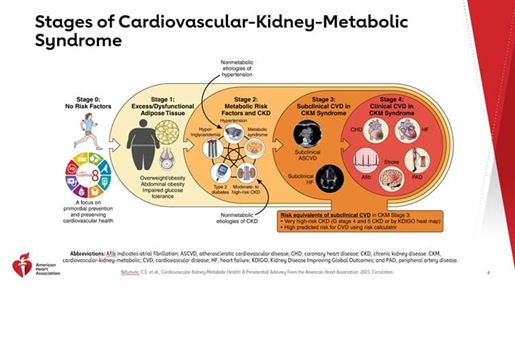Cardiovascular Kidney Metabolic Health: A Presidential Advisory From the AHA

- Cardiovascular-kidney-metabolic (CKM) syndrome is a systemic disorder with connections among heart disease, kidney disease, diabetes, and obesity.
- This presidential advisory describes the urgency of CKM syndrome, which disproportionately affects disenfranchised populations, suggests consensus on defining and staging the syndrome, offers suggestions for screening, and provides approaches and algorithms for each stage. It also describes the interdisciplinary team approach needed to effectively treat CKM syndrome, emphasizes the importance of addressing social determinants of health, identifies shortcomings in current efforts, and names knowledge gaps.
- The advisory is supported by a scientific statement that summarizes evidence related to the science, screening, prevention, and management of CKM syndrome and the related supporting materials below.
Related Resources
-
Cardiovascular-Kidney-Metabolic Health: A 2023 Presidential Advisory From the AHA Slide Set

Download Cardiovascular-Kidney-Metabolic Health: A 2023 Presidential Advisory From the AHA Slide Set (PPTX)
-
AHA Clinical Slide Series adapted from: The 2023 Scientific Statement From the AHA: A Synopsis of the Evidence for the Science and Clinical Management of Cardiovascular-Kidney-Metabolic Syndrome

Download AHA Clinical Slide Series (PPTX)
-
Cardiovascular Kidney Metabolic Health: Presidential Advisory Podcast

Co-chairs Dr. Chiadi Ndumele and Dr. Janani Rangaswamy discuss the long process of creating the advisory, why it is so important, and how they hope it can change health care. They also touch on some of the most important aspects of the advisory, including the stages of CKM syndrome, the consideration of SDOH factors, and the importance of breaking down silos in health care.
View the Cardiovascular Kidney Metabolic Health: Presidential Advisory Podcast